How to install and use Foliate on Linux
There are many e-book readers for all platforms and devices online. Linux also has some great options, but Foliate, a new Linux eReader, is doing everything differently. Foliate is neat, simple and integrates many of the powerful features you expect from an eReader application on a top tablet.
- 7 best tablets for reading digital books
Foliate is only available through source or Flatpak settings at the present time, but it is open source and will definitely be included in the repository of future distributions. Even, installing Foliate on any distribution currently using Flapak is very easy.
Install Flatpak
Before you get Foliate, you will need Flatpak. If you have not already installed Flatpak on your system, here is how to get started:
Ubuntu / Debian
sudo apt install flatpak Fedora
sudo dnf install flatpak OpenSUSE
sudo zypper install flatpak Arch Linux
sudo pacman -S flatpak Set up Flathub
You will need the Flathub repository to install the Foliate package. Flathub is the largest and most popular Flatpak repository. In most cases, when you want something via Flatpak, go to Flathub.
You can easily add an archive with Flatpak and a simple command.
flatpak remote-add --if-not-exists flathub https://flathub.org/repo/flathub.flatpakrepo Foliate settings
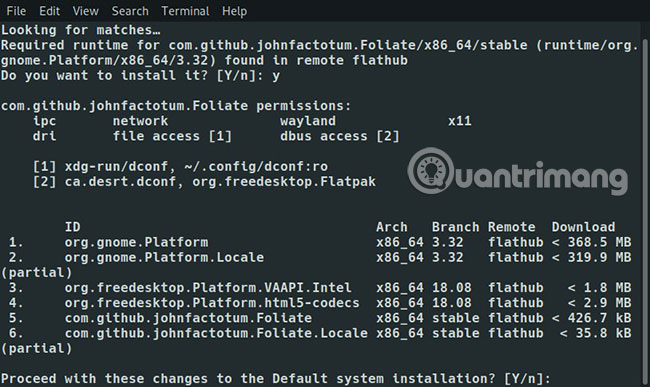
Please use Flatpak to install Foliate.
flatpak install flathub com.github.johnfactotum.Foliate Flatpak will also ask you to install dependencies as part of Foliate settings.
Foliate's features
Foliate has been installed and ready to use. Foliate is a graphical application designed to integrate well with GTK desktop. If you use GNOME, you just need to search for it by name. Other desktop environments will sort Foliate in the Office section of the application menu.
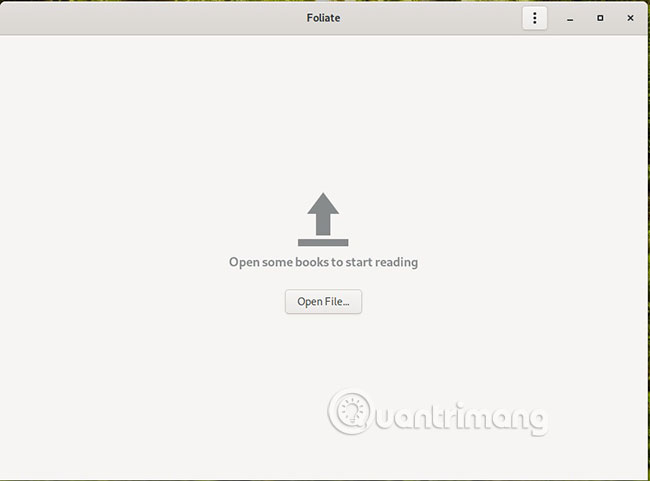
When you open Foliate for the first time, you will find it quite simple. Press the button to open the ebook file in the middle of the screen. Foliate supports a variety of ebook file types, so you can open any file you have without problems.
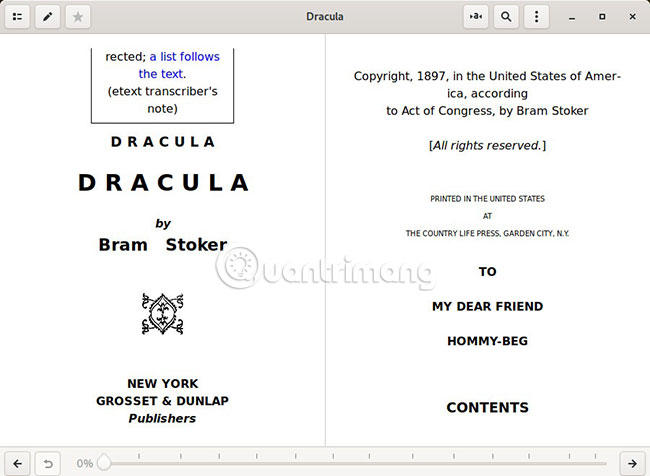
When Foliate first opens the ebook file of your choice, it will display like an open physical book, with two pages placed side by side. You can use the arrow at the bottom right of the window to move to the next page. If you prefer to move to a certain point in the book, use the slider to change the percentage of the book. If your book has a table of contents, you can also use it.
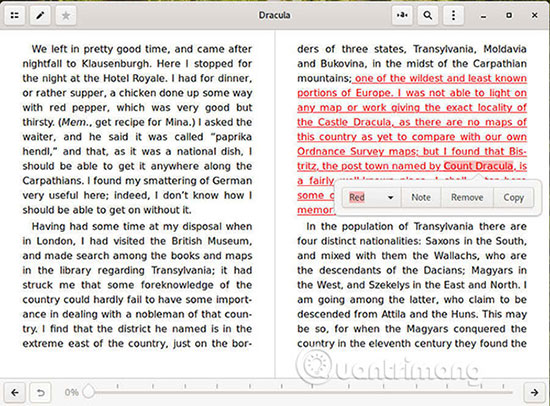
Highlight a word or phrase in the book. This brings up a new menu with options for word processing. On the left side of the menu, you can choose a color to highlight your text. The text will be highlighted for your reference.
Next, select the Note button . This option will allow you to create annotations in the ebook. You can go back to those annotations at any time, so this is a great feature for students to easily navigate to important parts of the text.
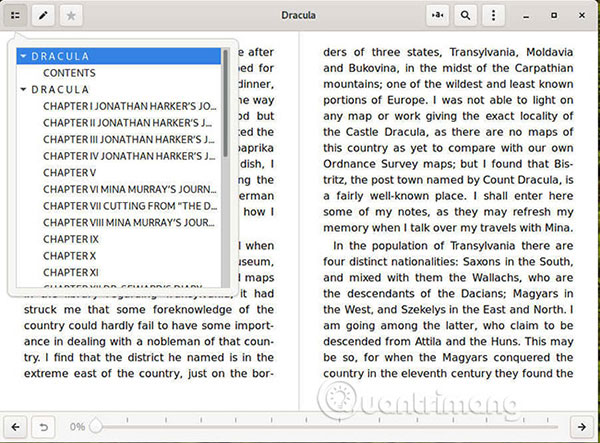
Select the list icon at the top left of the screen. That is the table of contents. When you do so, the full list will open, allowing you to choose which chapter you want to read.
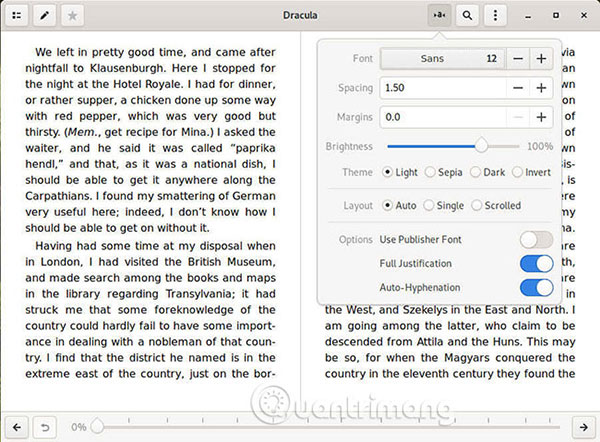
Next, find the 'A' symbol above Foliate. Click it to show your text settings. Here, you can modify the look of the book. Change the font size, page color, distance, margin and whatever you want to make the text easier to read.
Feel free to experiment with Foliate settings to turn it into a useful tool for your own needs. This eReader is still quite new, so wait for changes and updates from Flatpak. Don't forget to keep an eye on the distribution of the distribution you are using, as Foliate may appear at any time!
You should read it
- 7 best Linux distributions based on Red Hat
- Why is MX Linux a desirable Windows alternative?
- How to create USB Boot Live Kali Linux
- Basic Linux commands everyone needs to know
- What's new in Linux Kernel 5.18?
- 6 reasons why the Linux operating system often fails
- How to check the desktop environment you are using on Linux
- 8 best Linux distros for pentest
May be interested
- How to install Spotify on Linux
 spotify has actually supported linux for a long time. although most distributions do not include this application in the repository for license reasons, it is not really difficult to install this official player on a linux pc.
spotify has actually supported linux for a long time. although most distributions do not include this application in the repository for license reasons, it is not really difficult to install this official player on a linux pc. - How to Install VirtualBox on Linux
 setting up a virtual machine can be a great way to test alternative software or operating systems on a computer without altering or putting the existing system at risk.
setting up a virtual machine can be a great way to test alternative software or operating systems on a computer without altering or putting the existing system at risk. - How to install Deepin Linux
 deepin linux is an excellent distribution. so why not experience it on your computer? deepin has a variety of high-quality layouts / interfaces and great software.
deepin linux is an excellent distribution. so why not experience it on your computer? deepin has a variety of high-quality layouts / interfaces and great software. - How to Install Asahi Linux on an Apple Silicon Mac
 asahi linux is a project to port the linux kernel and related software to macs powered by apple silicon. it is still under development, but it has made significant progress in a short period of time.
asahi linux is a project to port the linux kernel and related software to macs powered by apple silicon. it is still under development, but it has made significant progress in a short period of time. - How to install and use TeamViewer on Linux
 teamviewer is a powerful tool that allows teams to collaborate and share their screens in real time. it is also extremely useful in remote technology support.
teamviewer is a powerful tool that allows teams to collaborate and share their screens in real time. it is also extremely useful in remote technology support. - How to Install Linux
 linux is the foundation of thousands of open source operating systems designed to replace windows and mac os. linux allows users to download and install it for free on any computer. because this is an open source platform, the number of available versions or distributions is very diverse and is developed by many different organizations. follow the basic instructions below to install all linux versions, especially some of the most popular distributions.
linux is the foundation of thousands of open source operating systems designed to replace windows and mac os. linux allows users to download and install it for free on any computer. because this is an open source platform, the number of available versions or distributions is very diverse and is developed by many different organizations. follow the basic instructions below to install all linux versions, especially some of the most popular distributions. - Should I install Arch Linux?
 arch linux is one of the most popular linux operating systems. arch linux is even easier to install than arch-based distributions like manjaro and antergos.
arch linux is one of the most popular linux operating systems. arch linux is even easier to install than arch-based distributions like manjaro and antergos. - How to install Handbrake on Linux
 handbrake is a powerful open source tool for encoding and editing videos. it includes a graphical control panel to manage encryption and even preview the results.
handbrake is a powerful open source tool for encoding and editing videos. it includes a graphical control panel to manage encryption and even preview the results. - How is Arch Linux different from other Linux versions?
 arch linux is arguably the most misunderstood linux distribution. many people find arch difficult to install and maintain.
arch linux is arguably the most misunderstood linux distribution. many people find arch difficult to install and maintain. - How to install and remove fonts on Linux
 the linux system has many integrated fonts but you still can't find the font you need. downloading and installing new fonts is very easy on linux and we will show you how to do this in the following article.
the linux system has many integrated fonts but you still can't find the font you need. downloading and installing new fonts is very easy on linux and we will show you how to do this in the following article.









 Compare Fedora and Ubuntu
Compare Fedora and Ubuntu 5 best Linux distributions for Windows users
5 best Linux distributions for Windows users How to create Live USB or CD ReactOS
How to create Live USB or CD ReactOS How to customize Ubuntu 16.04 LTS desktop
How to customize Ubuntu 16.04 LTS desktop How to install OBS Studio in Ubuntu
How to install OBS Studio in Ubuntu 3 ways to listen to the radio via Ubuntu Terminal
3 ways to listen to the radio via Ubuntu Terminal